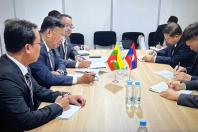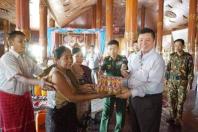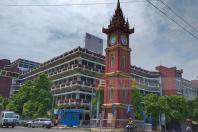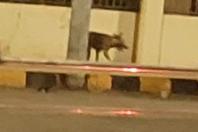
Every summer, I sat drinking tea with my friends every year and said that I was lucky to live in Myitkyina. I said like that when I heard the news about fire in the summer. The houses are located about ten or hundred feet from each other. Reporters from lower parts of Myanmar were amazed to see big houses with spacey compounds in the town. The reader will be amazed to see the big buildings, with the three or four acres yard, owned by Gurkhas and the ancient Kachin houses.
Like Myitkyina, the capital of Kachin State, the houses in every town, big village and small village have a big yard and it makes the people, who see them, happy. However, the opposite of that are families living in a small 10-foot-wide room with four or five people in pairs in refugee camps where hundreds of families live.
For more than ten years, they have to share toilets, wells and bathrooms. The sound of coughing in one room can be heard from two adjoining rooms. In the third wave of COVID-19, confirmed cases have been found in refugee camps where thousands of people are living. It will make them worry about their livings.
The rise of COVID-19 infection and mortality rates in Kachin State
Currently, there is a high level of COVID-19 infection in Kachin State, and the mortality rates of confirmed patients and suspected patients are on the rise. According to a statement from the Ministry of Health and Sports (MOHS), as of July 25, a total of 4,238 confirmed cases are found and 148 of them are died. A total of 2,322 people are still receiving medical treatment. The state health department said the list included those found to be infected with COVID-19 and they could not be examined to people who died without taking swab tests.
According to records from Shweku, Bhamo, Momauk, Myitkyina, Waimaw, Mogaung and Hpakant aid groups, more than 200 suspects were killed in the third wave of COVID-19. In addition, there are still many suspected deaths in the villages, and the death toll in July could be even higher if these suspected patients are included.
In Putao, a separate area in Kachin State, 92 people were found infected with virus and two were killed. At present, there is a high number of fever related cases in the villages in Sezinkyay and Tamakhan areas of Hpakant Township where no health care service is provided. Nine people including a doctor in Sewzin Village and more than 20 people in Tamakhan Village had been killed after July 7. At a time when the pandemic is on the rise, densely populated refugee camps are inevitably infected.
Crisis with COVID-19 infected camps
At present, there are 66 confirmed cases in KBC refugee camp in Injangdon ward, Myitkyina, 62 confirmed cases in Shwe Sak refugee camp, which has a population of more than 600, 20 confirmed cases in Moina KBC camp in Waimaw Township, with a population of nearly 3,000 and two cases at Jerminekaung Catholic refugee camp in Myitkyina.
Camp officials said they found only a little number of infection cases as they cannot conduct swab tests thoroughly. According to the camp officials, they found the confirmed cases in elderly people, who are ill, and not from the people who went to work at outside of the camps.
Zay Khaung, in-charge of the Injangdon refugee camp, said, “The camp is small and we cannot keep them separately. It is similar to the seasonal fever and not bad at all. It is not convenience to go to stay at the centers as we cannot provide help to them. It can infect into their family. The cases are found in every house and cannot be separated. The camp has been placed on lockdown for two weeks. There are more than 270 people in the camp. Most of them work outside on the farm. As a result, they are in trouble for food and their living,” he said.
Most of the refugee camps are currently locked down due to the high rate of infection in the city. Refugee camps with hundreds or thousands of refugees are in dire straits if the infection rates are increased. Refugees will face food shortages if we continue to make restrictions on them for one more month. Refugees and in-charges of the refugee camps in Kachin State are fearful of the escalation of COVID-19 outbreaks in refugee camps in the state.
Brang Sai, in-charge of the KBC refugee camp in Moina, which has a population of nearly 3,000, said on July 29, “We are holding meeting with social welfare associations and religious congregations. 20 of them are tested positive for the virus. They were sent to Waimaw Hospital Medical Center. They are feeding them. The population here is big and we have to share wells, bathrooms and toilets. It can be contagious and can spread easily to hundreds of people. We are afraid of that. We have contacted the health department and dealing with it as much as I can. The camp was placed on lockdown and those who are infected have been placed on lockdown. People who work outside and farmers are not allowed to enter in the camp for one month. The people inside the camp are not allowed to leave the camp for a month. People who can help also help as much as they can. We all share food. All we need is medicine and food.”
La Khaung, in-charge of the Trinity Camp, which has a population of more than 800 people, said that although there were sick people and tests had not been carried out as they have no test kit. Most of the refugees are facing food shortages due to travel restrictions. The main needs are food and medicine. They don’t know how to handle it in the long term.
"Our camp is located in the city, so people from our camp work at outside. The camp has been placed on lockdown. The main problem is food shortage. They haven’t received their monthly allowance in this month. Our concern is that there are outbreaks in refugee camps. In the long run, there will be no outside work. It is not safe to go and stay at the fields far from the city. We are worried about what will happen next,” said Naw Li, in-charge of the St. Paul Roman Catholic camp in Myitkyina, which has a population of about 300.
Supplies which gradually decline and lost hopes of refugees
From 2011 to the end of 2015, WFP provided rice, edible oil, beans and salt the refugees in government-controlled areas. Seventeen international organizations, including UNHCR and UNICEF, provided assistance. Donors from all over Myanmar and all over the world provided help. Since the beginning of 2016, only 70 percent of them have been supplied. Instead of providing rice, edible oil and beans, they have been provided cash. Ordinary families get 9,000 kyats each and poor families get 13,000 kyats each. It is no longer included for children under six months old. Years went by and the number of donors has dwindled, and for reasons such as the Rakhine conflict, most donors have moved their attention to the Rakhine conflict.
The Kachin Humanitarian Concern Committee (KHCC) repatriated 20 family households from Mansan Village, Mantong Township, northern Shan State, 26 households in Hpa Oan village, Kutkai Township and 10 households from Shwe Nyaung Pin Village, Waimaw Township, 76 households from Zidam village, Putao Township.
There are 253 displaced families, who want to go home, in Dabat Yang Village. In coordination with the Kachin State government and the Northern Command, the KHCC repatriated 216 households and the state government sent back 37 households. However, after February 1, 2021, after a series of political upheavals, clashes bewteen KIA and the Tatmadaw occurred and all projects were suspended.
Refugees and COVID-19 disaster in KIO-controlled areas
“We found hundreds of COVID-19 confirmed patients in Maijaryang. Infections are also reported in refugee camps. It is true that food was difficult to get due to travel restrictions. So far, 15,000 Sinovac vaccines from China have been vaccinated in Laiza. Gradually, the vaccination will be covered. The people from the refugee camps and we have the same policies. The main thing is to educate the people. Public care is the most effective way to care for people. They help each other with food. Encouragement from neighbors and families is most effective. We cannot reach to the bottom,” said Colonel Naw Bu.
Health workers from the Kachin State Health Department have been weakened by political change after February 1. Hundreds of people could be provided with a medical staff in the refugee camps formerly, but now they can no longer be deployed. Refugee aid groups are recruiting health professionals from outside. They are working with all available forces, said Dr. Tint Naing, Head of the Kachin State Health Department.
"This is a very worrying time for refugees. The way families gather in a 10-foot-round room makes it more contagious. We are also dealing with infections in refugee camps as much as we can. If the number of victims is high and the number of people who are not infected is small, they must be separated and treated. Vaccines are also available and will soon be vaccinated to people who are in line with the guidelines,” he said.










